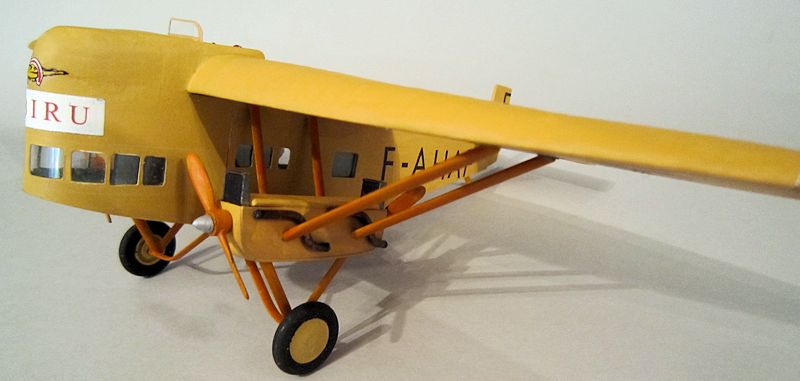
| KIT #: | |
| PRICE: | |
| DECALS: | |
| REVIEWER: | Chris Peachment |
| NOTES: | Scratch built |

| HISTORY |
In my long and arduous search to find the ugliest aircraft of all time, I have
frequently comes across blogs about the Farman Jabiru containing such phrases
“horrible” or “the flying whale” and even “that is just plain butt ugly”. Now if
they were talking about an earlier incarnation, the F-120 Jabiru tri-motor,
which has an uncowled radial engine on the nose, then I might have to agree that
that beast was homely.
But there
were in fact many different Jabirus, and this one, the Farman F-121, is my
favourite. That rounded nose, with curved windows in it, is so obviously copied
from art deco architecture of the period that it looks like Le Corbusier has got
at an aircraft. If it were British, it would probably have been called the
Farman Odeon, from the many Odeon cinemas of that period in Britain which all
adopted the curved corner and gave their name to the “Odeon style” of building.
They call it ugly. I say it is beautiful.
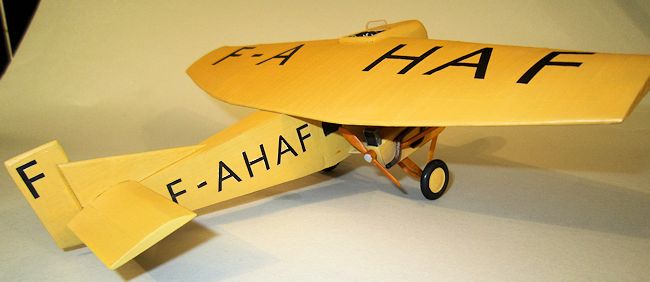
| CONSTRUCTION |
Is in fact straightforward, although it is best to lay in several extra sheets
of plastic card before beginning. This beast is guzzles plastic like dogs
pouncing on boxes of fried chicken.
The nose is best cut from a continuous sheet to be folded around that elegant
nose, and the windows must be measured and cut through very carefully with a
sharp scalpel blade. What little information I could find of the interior showed
a few scattered wicker chairs, and a bulkhead toward the nose. I painted the
interior Eau de Nil (Waters of the Nile), a colour which was fashionable in the
1920s, and Italian cockpit green comes
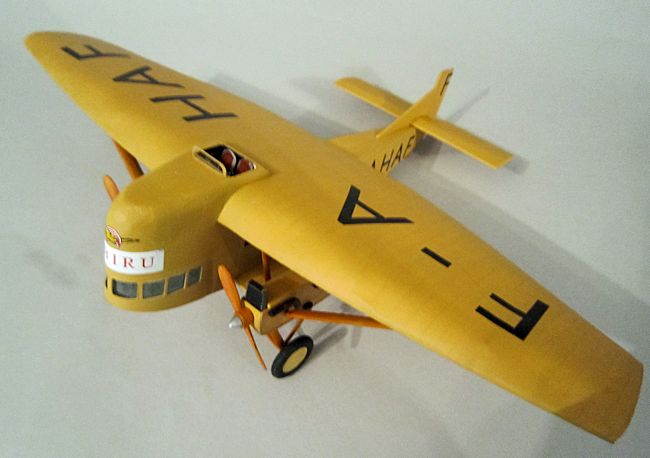 close. The bulkhead is brown wood. Paint
the exterior ahead of time, and once dry, insert a strip of clear plastic around
the nose, cemented with Humbril Clearfix, or any PVA wood glue.
close. The bulkhead is brown wood. Paint
the exterior ahead of time, and once dry, insert a strip of clear plastic around
the nose, cemented with Humbril Clearfix, or any PVA wood glue.
This is delicate and since you are going to be handling the nose, cover the
windows with masking tape. Don't press down too heavily, or you will be rewarded
with a rattling sound from inside, and no windows once tape is removed. A
dispiriting sight if the fuselage is closed off and finished. Then turn to that
barricade called the wing. The underside is the easy part. I then put together a
few internal ribs in aerofoil shape for support, and also the flat end plates.
Now take a sheet of the thinnest plastic card you have, and cut it out roughly
to plan, sticking to the trailing edge,
but with an overlap of at least two inches in front and at the tips.
Score the ribs on the underside, using a steel rule and biro, according to plan.
Then
glue the trailing edge down,
and leave to set. Once dry, you can start folding the upper skin over the ribs
and down onto the leading edge.
If you see any aircraft from that period in museums, you will note that any thin
aluminium skin takes on all sorts of lumps and dents from being handled, not
least around the edges of the wing where ground crew have been wading in a
little heavy-handedly. Don't try to replicate this. It will happen automatically
as you handle the model. My wing looks nicely battered, with the odd rib showing
through the skin here and there, and a leading edge that resembles a tortoise.
Turtle to you.
So too with the upper nose. If I had one of those nice vacuum forming machines,
I would have used that. Instead I built up layers of thick plastic card, with an
opening at the back for the cockpit and sanded it all to shape, while singing
the Lumberjack Song from Monty Python. This is not a hard and fast rule, so
please feel free to improvise. Handel's Messiah often proves just as successful,
no doubt due to divine intervention. La Marseillaise might be appropriate for
this particular aircraft. Once done, glue the wing on top, and the Rhino nose on
top of that.
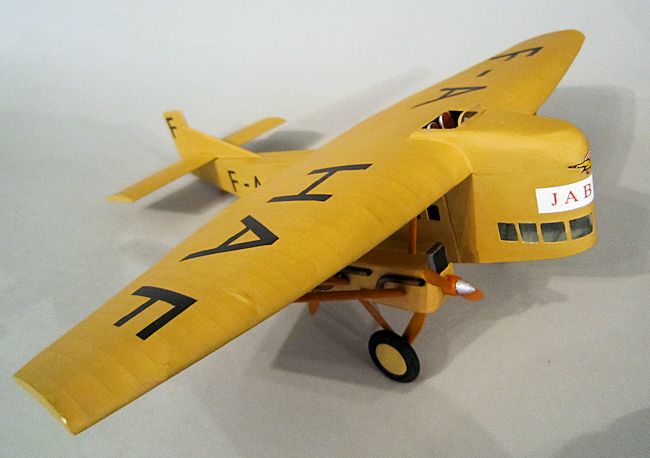 Start filling and sanding.
Then
make the little stub wings on either side, using the same technique as the main
wing. Note that engines vary a lot from aircraft to aircraft. Some have no
covers on top, leaving the cylinder heads exposed. Some are completely covered.
Some use two Lamblin lobster pot radiators on top, some use free standing
radiators like mine. Since I didn't have four spare engines, I decided to cover
mine. Exhausts came from gardening wire, bent with pliers.
The radiators from an old car.
The tail planes are a cinch, made from thick card and sanded down to the
right aerofoil shape.
Start filling and sanding.
Then
make the little stub wings on either side, using the same technique as the main
wing. Note that engines vary a lot from aircraft to aircraft. Some have no
covers on top, leaving the cylinder heads exposed. Some are completely covered.
Some use two Lamblin lobster pot radiators on top, some use free standing
radiators like mine. Since I didn't have four spare engines, I decided to cover
mine. Exhausts came from gardening wire, bent with pliers.
The radiators from an old car.
The tail planes are a cinch, made from thick card and sanded down to the
right aerofoil shape.
| COLORS & MARKINGS |
The rest of the beast got at least four coats of Lifecolor Italian Mimetic
Yellow 3, which is a pleasing shade and deepens to a sandy brow with advancing
coats. The lettering is about the limit of my decal making skills,
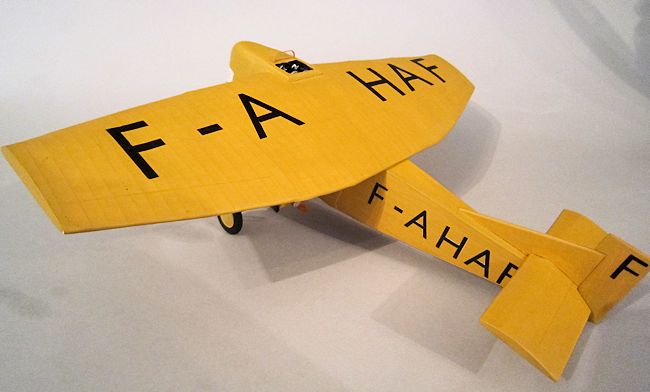 and should
cause no problem to anyone with a scanner and printer. It is done in Gill Sans,
which is a sans serif font devised in this period by Eric Gill for the new BBC.
The BBC building in London has mottos carved in this very font around its
interior stone walls. Some of them are very rude. The windscreen was cut from
clear plastic and the frame painted. And finally the master stroke of ingenuity,
the spinners. They were sawn off the tips of two plastic golf tees. I don't
spend my time hitting small balls around the countryside, but they had popped
out of a Christmas cracker, and since I am one of the afflicted, I looked at
them and wondered if they could be used on a future model aircraft.
and should
cause no problem to anyone with a scanner and printer. It is done in Gill Sans,
which is a sans serif font devised in this period by Eric Gill for the new BBC.
The BBC building in London has mottos carved in this very font around its
interior stone walls. Some of them are very rude. The windscreen was cut from
clear plastic and the frame painted. And finally the master stroke of ingenuity,
the spinners. They were sawn off the tips of two plastic golf tees. I don't
spend my time hitting small balls around the countryside, but they had popped
out of a Christmas cracker, and since I am one of the afflicted, I looked at
them and wondered if they could be used on a future model aircraft.
Like all afflicted people, I do this all the time. Many of my models with
tricycle undercarriages have nose weights inside made from odd nuts and bolts
picked up while pounding the pavements. Garages are especially useful for
automotive detritus, which piles up in odd corners of the man-cave.
| CONCLUSIONS |
I could think of nothing nicer than being inside this beast as it
flew through the night, high above the French midi, en route from Paris to Nice
in the South of France. In a dinner jacket and bow tie, I would pause beside the
grand piano, where Hoagy Carmichael was playing a selection of Cole Porter
before taking a large Martini and sauntering to the nose, where Ernest Hemingway
and Hadley, a boyish looking girl, are looking out at the stars.
They are on their way to Antibes where they will take up the new idea of
“sun-bathing”.
As the sun began to
rise, Hemingway scribbled a small idea in his notebook, a phrase which reads:
“The Sun... erm...
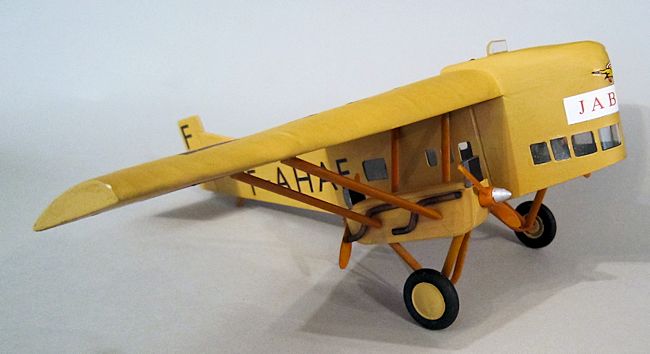 Rises.
Not bad, but it needs a little something extra.”
Rises.
Not bad, but it needs a little something extra.”
Meanwhile high above them in the tiny cockpit, Antoine de St-Exupery sat in the
pilot's seat, his eyes fixed on the horizon, while he listened for any variation
to the steady note of the engines and the roaring of the wind about his ears.
Beside him in the co-pilot's seat was a 15 year old boy who had begged a ride
from Paris called Albert Camus.
“You say you want to be a writer” said St-Exupery. The young man nodded. “I am
writing something about night flying,” he continued. “But I don't know what to
call it yet.”
The boy shrugged and said, “Night Flight, what else?” St-Ex took out a pencil,
and jotted down on his knee pad “Vol de Nuit”.
“Perfect,” he said.
“Do you ever wonder what all the passengers are doing down below?” said Camus.
“No, I don't think about them much,” said St Ex.
“I feel very cut off from them up here,”
said Camus, “not just by distance, but
they feel like a foreign tribe. Very remote.”
“Are you writing about that feeling,”
said St Ex
“Trying to,” said Camus. “But it is hard.”
“You could call it The Outsider,” said St Ex.
And the young Camus made a mental note: “L'Etranger”.
Down below Hemingway had finished his fifth martini and started on his hip flask
brandy. “Inspiring, isn't it?” he said to Hadley, gazing down at the
ever-brightening landscape beneath. He scored through “The Sun... erm... Rises”
in his notebook, and wrote instead “The Garden of Eden”.
| REFERENCES |
http://1000aircraftphotos.com/Contributions/KleinBernhard/7089.htm
http://www.findfreegraphics.com/image-39/farman.htm
http://www.teamflyingcircus.com/forum/f7/u-g-l-y-planes-3148/
http://1000aircraftphotos.com/Contributions/Braas/5269.htm
http://www.mission4today.com/index.php?name=ForumsPro&file=viewtopic&p=133245
for some good three view graphics.
The Sun Also Rises by Ernest Hemingway (1926, Scribners)
The Garden of Eden by Ernest Hemingway (1986, Scribners)
Night Flight (Vol de Nuit) by Antoine de St-Exupery (1932, Harmsworth)
The Outsider (L'Etranger) by Albert Camus (1942, Gallimard)
June 2014
If you would like your product reviewed fairly and fairly quickly, please
contact the editor or see other details in the
Note to
Contributors.